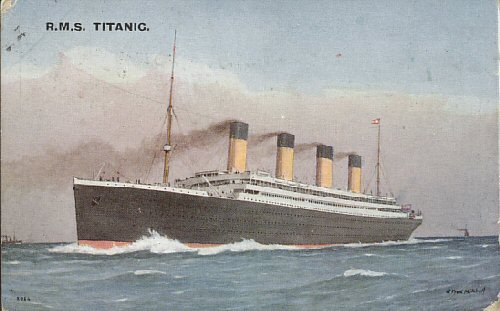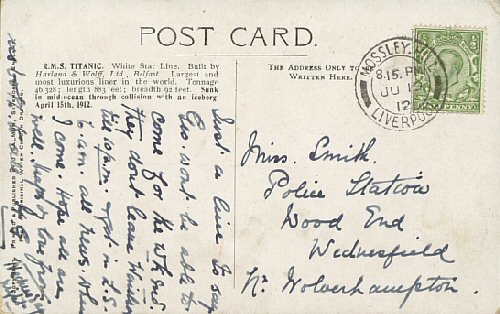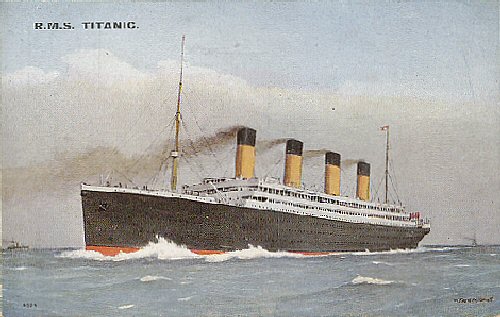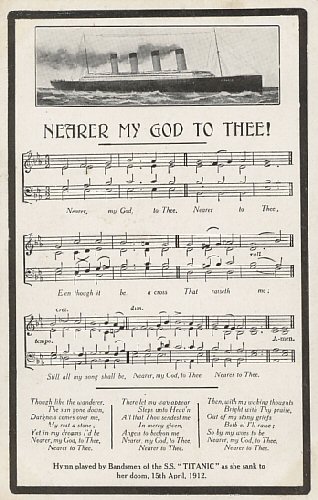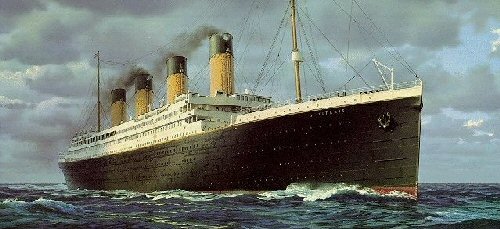
Hit an Iceburg and Sank 14 April 1912
Draught: 34 feet.
Displacement: 66,000 tons of water.
The Titanic had 4 funnels (smokestacks). Each was 62 feet tall and had a diameter of 22 feet.
The distance from keel to top of funnels was 175 feet.
The rudder was 78 feet high, weighed 101 tons and was cast in 6 separate pieces.
Titanic's 3 anchors had a combined weight of 31 tons.
"Triple screw" - 3 propellers. The 2 outer propellers had a diameter of 23 feet and the center propeller had a diameter of 17 feet.
Engines: Two four-cylinder steam reciprocating engines and one low pressure turbine engine. The turbine, which drove the center propeller, utilized the exhaust steam from the other engines. This design recycled the exhausted steam instead of wastefully venting it up the funnels. The result: an increase in efficiency.
The total horsepower of the engines was 51,000.
29 boilers - 24 double ended and 5 single ended.
159 furnaces.
16 watertight compartments.
15 transverse watertight bulkheads.
Equipped with 20 lifeboats (total capacity 1,178).
Titanic was built at the Harland & Wolff shipyards of Belfast, Ireland under the auspices of Mr. J. Bruce Ismay, managing director of the White Star Line. Her keel was laid down on March 31, 1909. She was the second in a trio of the "Olympic Class" of ships. Olympic being the first and Gigantic, later renamed Britannic, the last.
She was launched on May 31, 1911, just past noon, to a formidable crowd of well-wishers. There was no formal ceremony as it was not customary for the White Star Line to christen their ships. After just sixty-two seconds the Titanic slid safely down into the River Lagan and on her way to the fitting out basin.
The scant shell of Titanic awaited the arrival of the hundreds of skilled workers who would fill out her interior. And fill it they did. Under the direction of Thomas Andrews (chief draughtsman of Harland & Wolff) and his assistant Edward Wilding, the ship was tailored with the most opulent furnishings money could buy. In fact, when Lord William James Pirrie (managing director of Harland & Wolff) met with J. Bruce Ismay in 1907 to discuss the building of three new colossal liners, it was verbally agreed that money would be no object.
Sea trials for Titanic began on April 2, 1912. This day marked the first time her massive boilers were fired and her immense engines began to move under their own power. Various maneuvers were performed to test how well the ship handled under certain conditions. With the trials successful, Titanic obtained her passenger certificate and was dutifully handed over to her owners. She steamed out of Belfast and was safely landed at her new berth 44 at White Star's dock in Southampton.
Titanic set out on her maiden voyage on April 10, 1912. Her Captain, Edward J. Smith was in command. He was known as "the millionaires Captain" and was one of the highest paid in the world. It was customary for Captain Smith to take the White Star Liners on their maiden voyage. This would be "EJ's" last voyage however, since he was planning to retire to spend more time with his wife and daughter. After taking on additional crew, passengers and mail in Southampton it was off to Cherbourg to take on more passengers. Titanic's last stop, at Queenstown, saw the loading of the last of the passengers and mail.
Among Titanic's First Class passengers were Mr. J. Bruce Ismay, Mr. Thomas Andrews, Mrs. J.J. ("the unsinkable" Molly) Brown, Grand Trunk Railroad president Mr. Charles M. Hays, President Taft's military aide Major Archibald Butt and the richest man in the world, Colonel John Jacob Astor along with his eighteen year old second wife Madeline. Other First Class passengers included the prestigious of New York and Philadelphia's Mainline society.
Second Class mainly consisted of professionals on holiday and families who may have booked First Class passage on other ships but were excitedly "forced" to downgrade to Second Class accommodations on Titanic (a coal strike had laid up most of the other ships). These passengers included Mr. & Mrs. Benjamin Hart and their young daughter Eva, Mrs. Allen Becker with her 3 children and Mr. Lawrence Beesley, a school teacher on holiday.
The passengers in Third Class or Steerage consisted mainly of Irish immigrants and those of Mediterranean descent, planning to make a new life in a new country. Many of the families had 6 or more children. Among these passengers was Mr. Daniel Buckley, Mr. & Mrs. Frederick Goodwin and their 6 children, Mr. August Wennerstrom, Mr. & Mrs. Bertram Dean with their 2 children. Mr. & Mrs. Frank Goldsmith with son Franky came along with a family friend.
Life aboard the Titanic was anything but boring. First Class truly lavished in the great ship's lustrous surroundings. The beauty and elegance of her exquisite Grand Staircase, A La Carte Restaurant, Palm Court, Cafe Parisian, Smoking Room, Library, elegantly decorated Staterooms, elevators, state-of-the-art Gymnasium, Turkish Bath and heated Swimming Pool rivaled the most luxurious hotels of Europe. In Second Class the Library, Smoking Room and Dining Room were the enlightenment and enjoyment of many. There was even an elevator for the Second Class passengers. Such a thing was never heard of on another ship. Even Third Class, with its Smoking Room, General Rooms and Dining Saloons, rivaled Second Class on many another ship.
The evening of Sunday, April 14th, was reasonably uneventful. The sea was flat calm, the air was brisk but there was no wind. The night was a sea of stars for there was no moon to dim their view. Most passengers were now getting ready to retire for the evening. Some First Class passengers could be found in the lounge playing bridge and other card games. There was talk about a couple of ice warnings which had been received during the day from other steamers; no cause for alarm. It was also rumored that Titanic could quite possibly beat Olympic's Maiden Voyage speed in getting to New York. Many felt she would dock on Tuesday evening, April 16, instead of her scheduled Wednesday arrival.
At around 11:40 p.m., three pulls of the crow's nest bell along with lookout Frederick Fleet's immortal words, "Iceberg, right ahead", would forever change the course of history.
The events which followed cannot wane with time's passage. Never to be forgotten is the moral strength, valor and courage carried out by Titanic's passengers and crew during her last hours. Mr. Strauss, offered a place in boat #8 because of his age, refuses because "I will not go before the others." Mrs. Strauss refusing to leave her husband, desiring instead that they enter eternity together. The band on deck, playing cheerful ragtime tunes to calm the distressed crowds. The engineers never once abandoning their posts in an effort to keep the lights burning until the very end.
The 1,523 gallant souls stood by as the boats were sent away, knowing that it would take a miracle for them to be saved. It is difficult to imagine the 705 survivors watching in terror and anguish as their husbands, wives, children and dreams all perished.
